2024 LSAA Design Award Entry #2863 Tumbalong Green Amphitheatre
|
ID NUMBER |
2863 |
|
ENTRY CATEGORY |
2 Medium Structures |
|
ENTRANT ROLE |
Engineer / Install |
|
PROJECT NAME: |
Tumbalong Green Amphitheatre Roof |
|
APPLICATION: |
Public Amphitheatre roof covering |
PROJECT DESCRIPTION:
Creating a showpiece architectural structure in Darling Harbour, the Tumbalong Green Amphitheatre is a remarkable marriage of beautiful elements and engineering expertise. Exemplifying the stunning possibilities of lightweight structure design, the soundshell curves up and over the stage, appearing to almost float over the performance space and encourages sound to wash over the audience like a breaking wave.
An example of architectural design meets functionality, the combination of Cross Laminated Timber (CLT) structural elements supporting a 1000 square metre PVC membrane have created a lightweight, and visually appealing public amphitheatre roof.
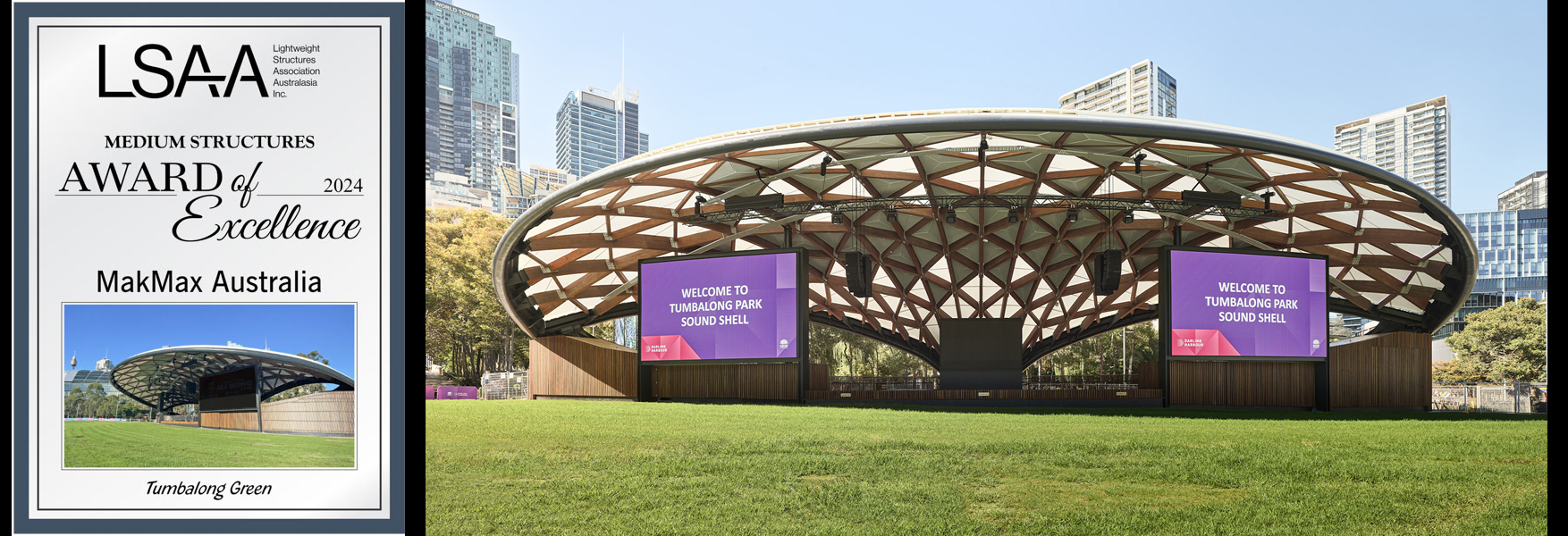
2024 LSAA Design Awards Entry #2862 Wangun Amphitheatre
|
ID NUMBER |
2862 |
|
ENTRY CATEGORY |
2 MEDIUM STRUCTURES |
|
ENTRANT ROLE |
Designer / Engineer / Fabricator / Installer |
|
PROJECT NAME: |
Wangun Amphitheatre |
|
APPLICATION: |
Communal performance and meeting space |
PROJECT DESCRIPTION:
Commissioned by the Gunaikurnai Land and Waters Aboriginal Corporation (GLaWAC), the Wangun Amphitheatre stands as a beacon of cultural celebration and architectural excellence. This remarkable circular meeting space features five elliptical tensile membrane canopies representing the Gunaikurnai clan shields, and a striking delta-shaped stage canopy inspired by the iconic boomerang, wangun in the Gunaikurnai language.
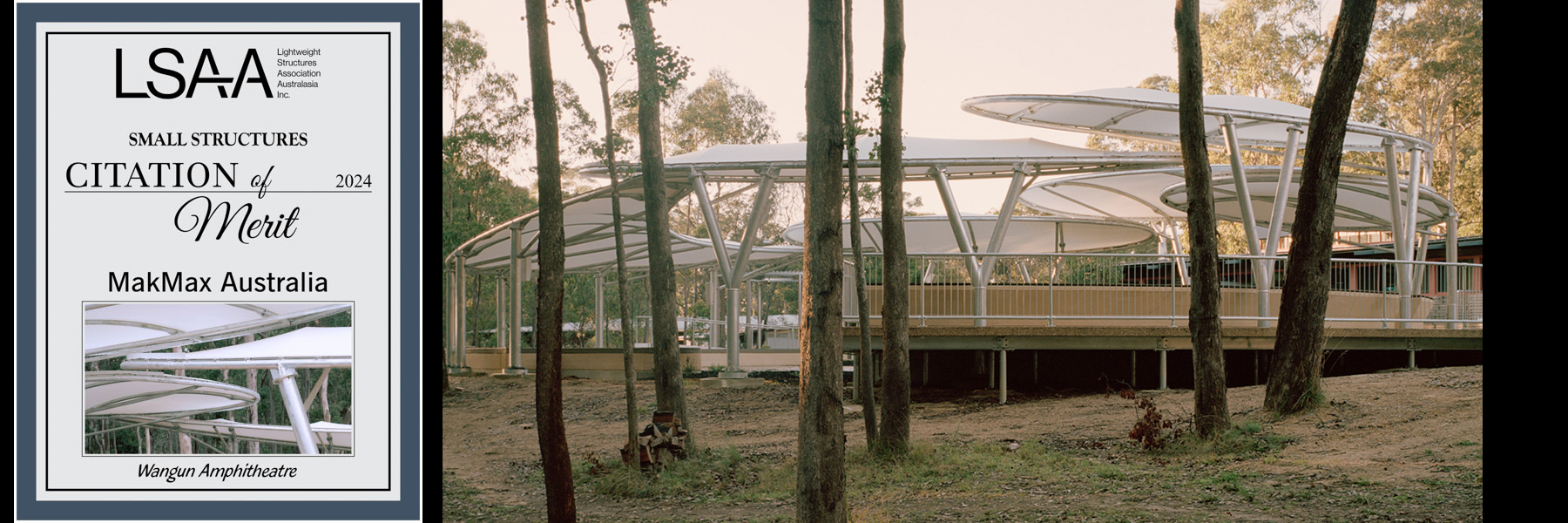
|
ID NUMBER |
1861 |
|
ENTRY CATEGORY |
1 - Small Structures |
|
ENTRANT ROLE |
Design / Engineer / Fabrication / Installation |
|
PROJECT NAME: |
North Melbourne Primary School Circles |
|
APPLICATION: |
School Shade Structures |
PROJECT DESCRIPTION:
The North Melbourne Primary School has unveiled an innovative vertical campus that maximises limited outdoor space through elevated play areas and creative design elements. A standout feature of this campus is the three circular shade structures, each positioned at different levels, seamlessly connecting indoor and outdoor spaces.
These vibrant orange shade structures are composed of 11.5m diameter rolled steel circles, adorned with 66 printed PVC mesh panels each.
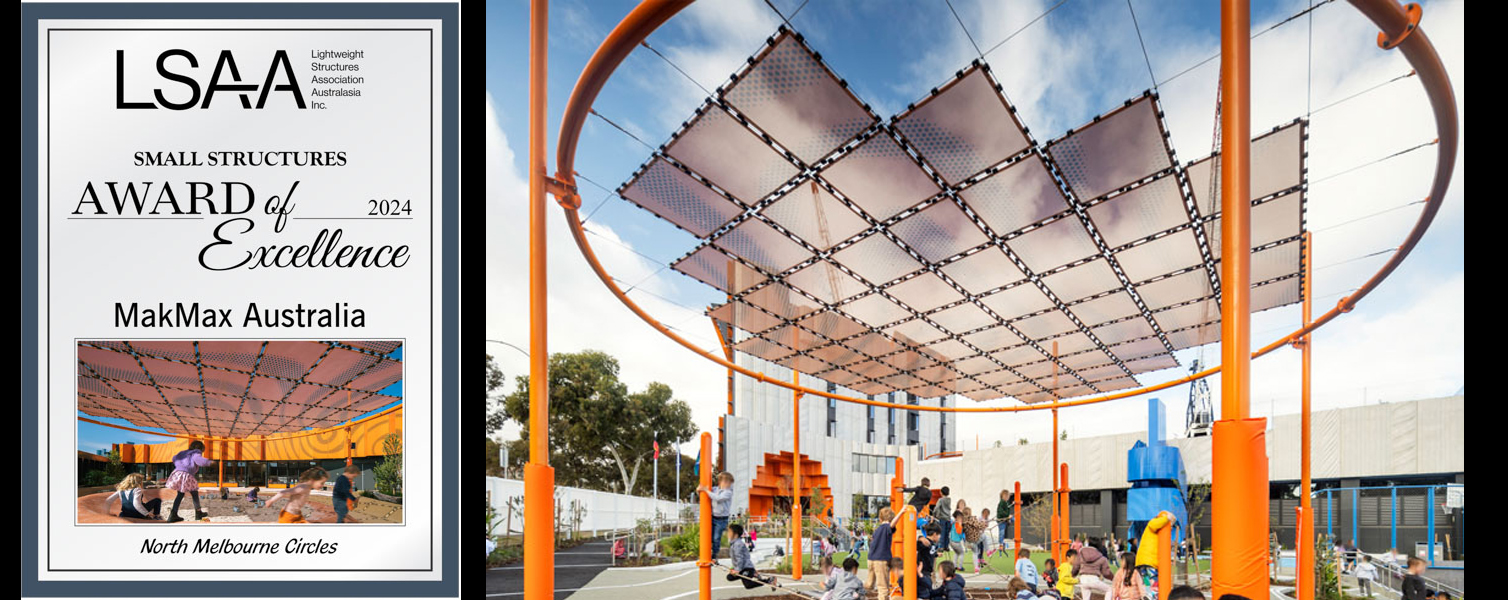
IDENTIFICATION NUMBER 5874
ENTRY CATEGORY (1-6) 5 ALTERNATE CATEGORY (1-6) 6
ENTRANT ROLE: Fabricator
PROJECT NAME: Metro Sports Facility
APPLICATION OF PROJECT: Interior acoustic membrane
PROJECT DESCRIPTION:
Fabric Structures was instrumental in the development of the Metro Sports Facility in Christchurch, focusing on the design, engineering, procurement, and installation of a custom ceiling panel solution for the aquatic center. Our task was to create a ceiling system with dual functionalities: an acoustic layer on the underside facing the pools to absorb sound and reduce echo, and a solid membrane on the top side to support the plenum area above. We worked closely with architects and engineers to ensure the panels met both aesthetic and functional requirements. Our precise engineering and installation processes delivered a high-quality solution that enhanced the acoustic environment while maintaining structural integrity. This project showcases our capability to provide innovative fabric solutions tailored to complex needs, contributing significantly to the Metro Sports Facility’s role as a leading sports and recreation venue in Christchurch.

2024 LSAA Design Awards Entry #6725 Bank of Indonesia Millennial Function Hall
ID NUMBER 6725
ENTRY CATEGORY 6 - International Projects
ENTRANT ROLE Designer / Installer
PROJECT NAME: Bank of Indonesia Millennial Function Hall
APPLICATION: Dome Canopy
PROJECT DESCRIPTION:
The Bank of Indonesia Millennial Function Hall ETFE dome, with a diameter of about 53 meters and spanning 2,700 square meters, is a remarkable architectural feat. Constructed from 325 ETFE cushions, the dome is celebrated for its striking appearance and excellent light transmission, allowing natural light to beautifully illuminate the space below.
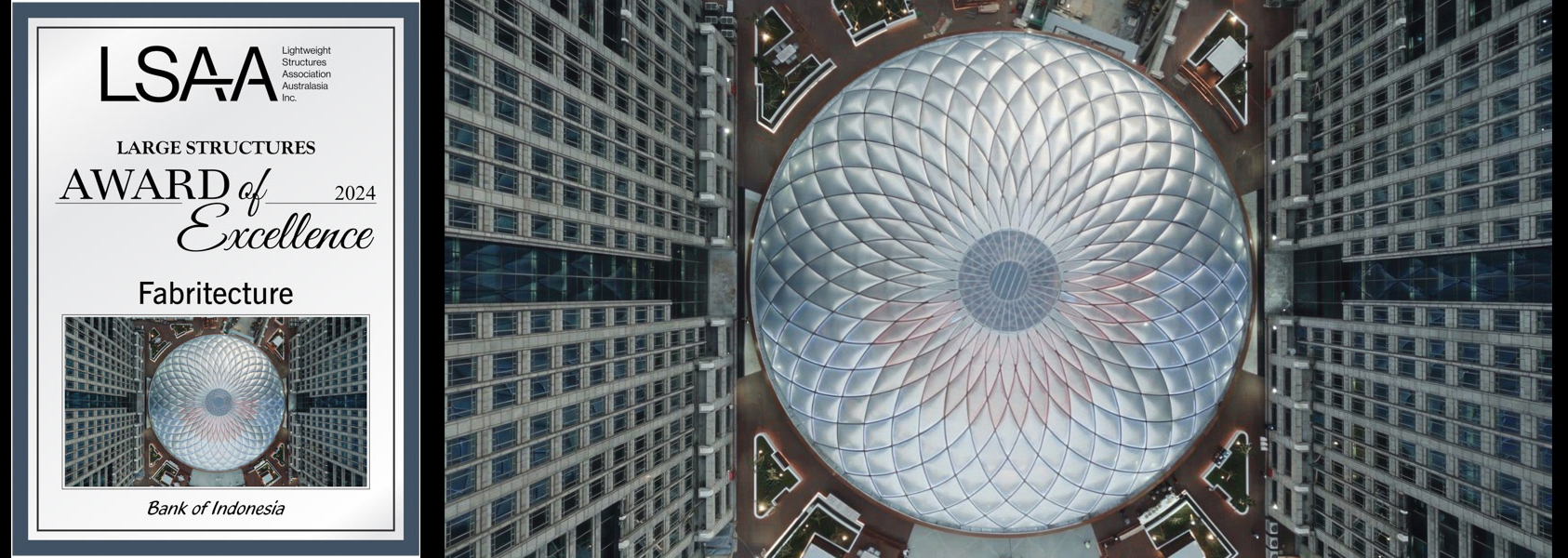
PROJECT NAME: National Throws Centre of Excellence
PROJECT DESCRIPTION:
Fabritecture was contracted for the design and construction of a Serge Ferrari TX30 throws run up canopy for the State Athletics Facility at the Queensland Sports and Athletics Centre (QSAC) in Nathan, Queensland. The tensile building was built to house discus and hammer throwing. The result is a stunning and functional canopy that enhances the sports complex and provides a world-class facility for athletes to train and compete in.
ID NUMBER 4712
ENTRY CATEGORY 4 – Glazing and Vertical Facades
ENTRANT ROLE Designer / Installer
PROJECT NAME: The Bower Tree
APPLICATION: Restaurant Precinct Facade
PROJECT DESCRIPTION:
Fabritecture was engaged in designing and constructing the striking aluminium façade screens for the Bower Tree dining precinct in Sippy Downs, situated on the Sunshine Coast.
Fabritecture provided a complete design-to-implementation service for custom solutions including prototyping, samples, and engineering in the early design stages through to a diligent fabrication process and on-site construction.
The team took a creative and forward-thinking approach by designing intricate curved panels made of perforated aluminium that elegantly encompassed the main structure. Additionally, they employed flat perforated panels for the parking structure, resulting in an architecturally stunning and contemporary masterpiece that captivates the eye.
APPLICATION OF PROJECT: Sports Court Canopy
PROJECT DESCRIPTION:
A specialised canopy structure was commissioned for the Field of Dreams project at Oxford Falls Grammar School in New South Wales, Australia. The design aimed to provide weather protection for two competition playing courts situated on the upper level of a two-story building, covering 2,200 square metres.
In addition to the canopy made of PTFE, stainless steel mesh was incorporated around the perimeter of the open-air facility. The rated mesh effectively enclosed the area and acted as a barrier to prevent equipment from falling through and provided fall protection for users of the courts all while maintaining adequate air circulation.
ID NUMBER 2284
ENTRY CATEGORY 2 – Medium structures
ENTRANT ROLE Designer / Installer
PROJECT NAME: MSU John Goodman Amphitheatre
APPLICATION: Amphitheatre canopy
PROJECT DESCRIPTION:
The MSU John Goodman Amphitheatre stands as a testament to innovative design meeting environmental challenges. Covering 6,792 square feet, and constructed with PVC TX30 material for durability and weather resistance, it offers exceptional acoustics and a versatile venue for concerts, plays, lectures, and cultural events, ensuring a premier outdoor experience for performers and audiences alike.
DESIGN / FABRICATION / INSTALLATION BRIEF
Missouri State University (MSU) sought to construct a versatile outdoor amphitheatre for diverse performances and events, including concerts, theatre, lectures, and cultural activities.
ENTRY CATEGORY 3 Large Structures
PROJECT NAME: Te Hiku Sports Hub
APPLICATION: Insulated Enclosure
PROJECT DESCRIPTION:
The Te Hiku Sports Hub in Kaitaia, New Zealand, is a state-of-the-art leisure and sports facility designed to cater to the diverse needs of the local community year-round. This innovative project consisted of two insulated wings connected by a central shared space, each tailored to specific functions.
The first wing, a 16.5m x 75m serpentine enclosure, is dedicated to gym spaces and administrative offices. This design not only maximizes the use of space but also ensures that the administrative functions are seamlessly integrated into the facility.
APPLICATION OF PROJECT: Stadium Roofing Canopy
PROJECT DESCRIPTION:
Yarrow Stadium in Taranaki was scheduled for a major redevelopment to comply with modern earthquake regulations and ensure the venue remained fit for purpose, aligning with the grow city’s cultural and sporting needs. Following the declaration of the west stand as earthquake-prone in 2018, we were commissioned to design, engineer, and provide a lightweight fabric roof solution that would integrate with the existing structural steel of the west grandstand, also known as the Noel & Melva Yarrow Stand.
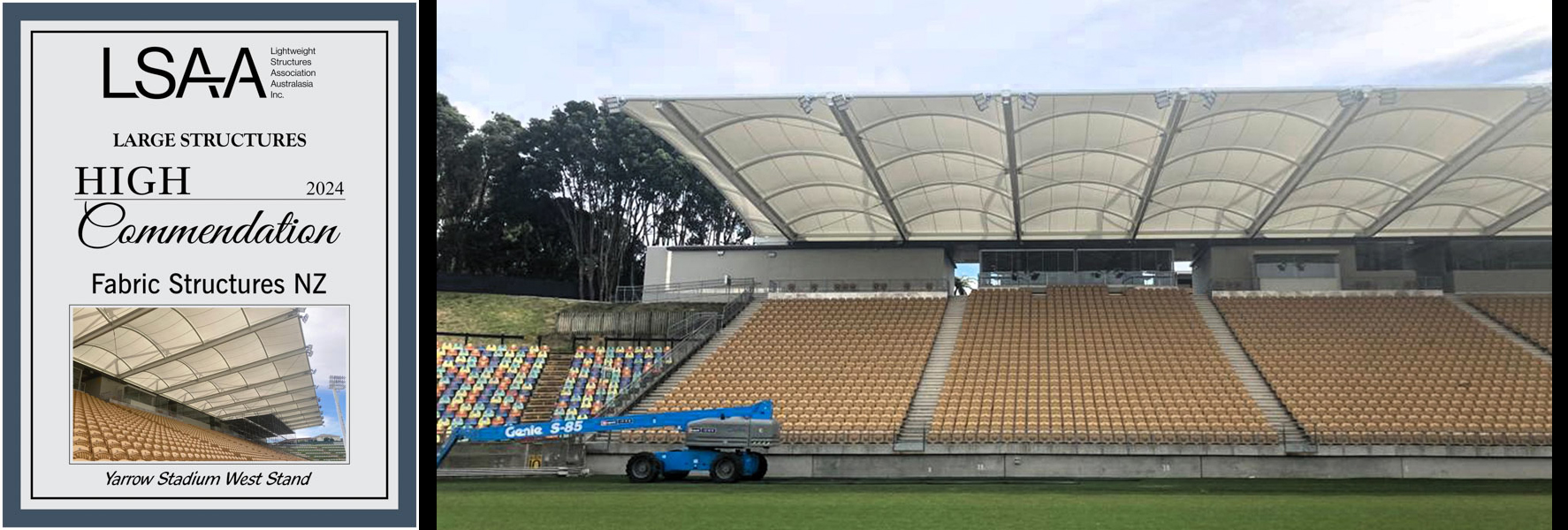
IDENTIFICATION NUMBER 3214 Hamilton Workingman’s Club Canopy
PROJECT DESCRIPTION:
Hamilton Workingmen's Club was established in 1955, and in the last two decades has experienced significant growth with more than 7000 members, to become one of the Premier Clubs in New Zealand. Infrastructure development is important to both the club and community, and over the years the club has invested in maintaining and elevating their amenities. Fabric Structures was engaged to design, fabricate, and install a new partial enclosure over the green at the Hamilton Workingmen's Club. This project aimed to provide a versatile, weather-resistant space for club members and visitors, enhancing the usability of the green throughout the year.
DESIGN / FABRICATION / INSTALLATION BRIEF
The Kina building at Green School New Zealand was conceived as a groundbreaking educational facility, designed to embody sustainable and innovative principles. The client’s vision was for a building that would integrate biophilic design with neuroarchitecture, enhancing both cognitive function and emotional well-being. The challenge was to create a structure that not only supported Green School’s commitment to holistic education and environmental stewardship but also reflected a deep connection to nature.
In addressing the design brief, Fabric Structures focused on several key aspects. The project demanded the use of cutting-edge fabric materials that would contribute to both the aesthetic and functional goals of the building.
PROJECT DESCRIPTION:
Matakana School aimed to enhance its usable exterior space by creating a sheltered area that could be utilized by staff and students throughout the year. The shelter was designed to provide protection from both the sun and rain, functioning as an external extension to the existing school hall. This canopy extension is part of the school’s ongoing efforts to improve facilities and support educational programs. The project is a key element of a broader strategy to upgrade the school's infrastructure, which also includes weatherproofing over 70% of the existing buildings. This initiative reflects the school's commitment to creating a supportive learning environment, ensuring that students have access to quality outdoor and indoor spaces for various activities.















